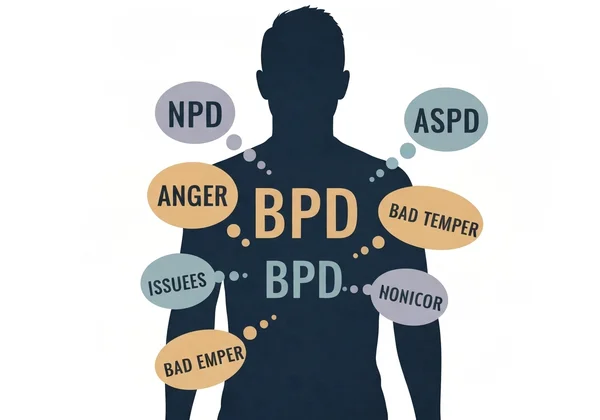BPD in Men: Overlooked Symptoms, Misdiagnosis, & How to Take a BPD Test
Introduction: Breaking the Mold: Why BPD in Men Often Goes Undetected
When we hear "Borderline Personality Disorder," the image that often comes to mind is one shaped by media and outdated stereotypes—frequently, a woman experiencing intense emotional turmoil. But this picture is incomplete and, frankly, misleading. The reality is that BPD in men is a significant and often overlooked issue. Men struggle with the same core symptoms of emotional dysregulation, unstable relationships, and identity disturbance, but societal expectations often force these symptoms into different, more "masculine" expressions. This leads to a silent struggle, frequent misdiagnosis, and countless men who feel profoundly alone and misunderstood. What are the key signs of BPD that are often overlooked in men?

Understanding this unique presentation is the first, crucial step toward clarity and healing. It’s about looking past the stereotypes to see the person underneath who is in genuine pain. If you're a man questioning your own intense emotions, or if you're concerned about a man in your life, this article will shed light on the overlooked symptoms and common diagnostic pitfalls. If you're asking 'Am I borderline?', taking a preliminary BPD test can be the first step towards getting answers. You can take our free BPD test to explore these patterns in a safe, confidential space.
Understanding Male BPD Symptoms Beyond Stereotypes
While the underlying criteria for Borderline Personality Disorder are the same for everyone, societal gender roles heavily influence how these symptoms manifest. Men are often discouraged from showing vulnerability, sadness, or fear. Instead, these feelings are frequently channeled into behaviors that appear aggressive, impulsive, or antisocial.
Explosive Anger and Outbursts: More Than Just "Bad Temper"
One of the most prominent yet misunderstood signs of male BPD symptoms is explosive rage. This isn't just a "bad temper" or poor anger management. For a man with BPD traits, this anger is often a desperate, outward expression of deep internal pain, fear of abandonment, or overwhelming shame. A seemingly minor trigger can unleash a disproportionate and intense reaction because it taps into a wellspring of unresolved emotional agony. This rage can be terrifying for both the man experiencing it and those around him, often leading to damaged relationships and a cycle of guilt and shame.

Substance Abuse and Reckless Behavior: Masking Deeper Pain
To numb the chronic feelings of emptiness, emotional chaos, or anxiety, many men with BPD turn to external coping mechanisms. This can manifest as substance abuse (alcohol or drugs), gambling, reckless driving, or other high-risk behaviors. These actions provide a temporary escape from the internal storm. Society often dismisses this as simply "boys being boys" or thrill-seeking, failing to recognize it as a desperate attempt to self-medicate profound emotional distress. The results from a BPD test can often highlight this connection between behavior and internal pain. If this pattern feels familiar, an online BPD screening can help you begin to connect these behaviors to underlying emotional patterns.
Hidden Vulnerability: The Mask of Independence and Fear of Abandonment
The intense fear of abandonment is a core feature of BPD. In men, this fear is often hidden behind a mask of hyper-independence, emotional detachment, or control. A man with BPD might appear aloof or push people away as a preemptive strike against being left. He might project an image of not needing anyone while, internally, he is terrified of being alone. This push-pull dynamic in relationships—desperately wanting closeness while simultaneously sabotaging it—is a hallmark of the disorder that is often missed in men.
Chronic Emptiness and Identity Confusion: Internalized Struggles
While men may be less likely to voice feelings of emptiness or confusion about who they are, these internal struggles are just as present. This can look like frequently changing jobs, friend groups, or life goals, always searching for something that will finally make them feel whole or "real." It may also present as a kind of emotional numbness or a feeling of being a "chameleon," constantly adapting their personality to fit in without a stable sense of self. This deep-seated identity disturbance is a painful and isolating experience.
Why BPD in Men is Often Misdiagnosed
The distinct manifestation of symptoms in men contributes directly to a high rate of misdiagnosis. Clinicians, influenced by the same gender biases as the rest of society, may fail to look past the surface-level behaviors to see the BPD core beneath.
Overlap with Narcissistic Personality Disorder (NPD) and Antisocial Traits
The externalizing behaviors seen in borderline personality disorder men, such as anger, impulsivity, and a seeming lack of empathy during an emotional outburst, can easily be mistaken for Narcissistic Personality Disorder (NPD) or Antisocial Personality Disorder (ASPD). A clinician might see the rage and recklessness and diagnose ASPD, or see the need for validation and reactive anger and diagnose NPD, completely missing the underlying fear of abandonment, emotional dysregulation, and identity confusion that point to BPD.

The Impact of Gender Bias and Societal Expectations in Diagnosis
Gender bias in mental health is a well-documented problem. A man presenting with intense anger is more likely to be seen as "aggressive" or "antisocial," while a woman presenting with the exact same symptom might be seen as "emotionally unstable." These diagnostic biases prevent men from receiving the correct diagnosis and, consequently, the most effective treatment, like Dialectical Behavior Therapy (DBT), which is specifically designed for BPD. For those questioning their diagnosis, a confidential quiz can provide a different perspective.
When Rage is Mistaken for Simple Anger Management Issues
Perhaps the most common misinterpretation is labeling the explosive anger of BPD as a simple "anger management problem" or Intermittent Explosive Disorder. This approach fails to address the root cause. The anger in BPD is not the problem itself; it is a symptom of deeper emotional pain and dysregulation. Treating only the anger without addressing the underlying BPD is like treating a cough without diagnosing the pneumonia causing it. This is why a comprehensive screening, like a detailed BPD test, which looks at all nine DSM-5 criteria, is more insightful than focusing on a single symptom like anger.
Seeking an Accurate Assessment and Path Forward
If this description of BPD in men resonates with you, it's important to know that there is a clear path toward understanding and healing. Recognizing the possibility is the first brave step.
The Importance of a Comprehensive Mental Health Evaluation
An online screening tool is an excellent starting point, but it is not a substitute for a formal diagnosis. The only way to get an accurate diagnosis is through a comprehensive evaluation with a qualified mental health professional, such as a psychologist or psychiatrist. They will conduct a thorough assessment of your symptoms, history, and experiences to provide a clear and accurate picture.
Finding a Knowledgeable Professional Who Understands BPD in Men
When seeking help, it's vital to find a therapist who is knowledgeable about personality disorders and understands the nuances of how BPD presents in men. Don't be afraid to ask potential therapists about their experience with BPD and their approach to diagnosis in male clients. Finding the right professional fit is key to effective treatment.
How a BPD Test Can Offer Initial Clarity
Feeling uncertain and overwhelmed is normal. You may wonder if your experiences are "serious enough" to warrant a professional evaluation. This is where an initial screening can be invaluable. A free and anonymous BPD test, like the one offered on our website, can help you organize your thoughts and validate your concerns. Understanding the questions in a BPD test can itself be educational, shedding light on patterns you may not have noticed. It provides a preliminary risk assessment that can give you the confidence and clarity needed to take the next step and start your assessment.

Beyond the Stereotypes: Embracing Understanding and Healing for Men with BPD
The path for men with BPD has been obscured by stereotypes and misunderstanding for too long. Your struggles are real, valid, and deserving of compassion and effective care. Recognizing that symptoms like explosive anger, substance use, and intense relationship patterns may be rooted in BPD is a revolutionary act of self-awareness. Healing begins with understanding, and understanding begins with asking the right questions.
You are not alone in this. If you see yourself or a loved one in these descriptions, we encourage you to take the first step with our free BPD test. Visit our site to take this free, 10-question screening. A BPD test is a confidential and insightful starting point on your journey toward clarity, healing, and a richer, more stable life.
Disclaimer: This article is for informational purposes only and is not a substitute for professional medical advice, diagnosis, or treatment. The test on this platform is a screening tool, not a diagnostic instrument. If you are in a crisis, please call or text the 988 Suicide & Crisis Lifeline at 988 or contact your local emergency services.
Frequently Asked Questions About BPD in Men
Do men experience BPD differently than women?
Yes, while the core symptoms defined by the DSM-5 are the same, men often exhibit more "externalizing" behaviors. This includes explosive anger, substance abuse, and physical impulsivity, whereas women may show more "internalizing" behaviors like self-harm and expressions of intense sadness or emptiness. These differences are largely shaped by societal gender expectations.
Can BPD in men be mistaken for other conditions like NPD or anger issues?
Absolutely. This is one of the biggest challenges. The outward aggression and impulsivity can look very similar to Antisocial Personality Disorder, while the reactive anger and sensitivity to criticism can be confused with Narcissistic Personality Disorder. It is frequently mislabeled as just an "anger management problem," which overlooks the deep-seated fear of abandonment and emotional pain driving the behavior.
What are the key signs of BPD that are often overlooked in men?
Key overlooked signs include intense but hidden fear of abandonment (often masked by a show of independence), chronic substance use as a way to numb emotions, a pattern of unstable jobs and relationships driven by identity confusion, and rage that is actually a manifestation of deep emotional pain rather than simple aggression.
How can men get tested for Borderline Personality Disorder?
The formal diagnostic process involves a comprehensive psychological evaluation by a qualified mental health professional. However, a great first step is to take a confidential online BPD test. Our BPD test is designed to help you identify potential symptoms and patterns in your life, providing you with valuable information to bring to a professional. You can explore your symptoms with a free initial screening on our website.